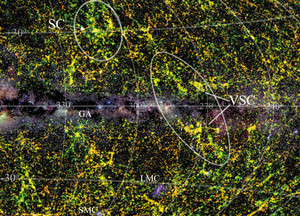
Thomas Jarrett (UCT)/Max Planck Institute
The Milky Way (blue and white, along the horizontal axis) and the locations of the new Vela supercluster (VCS) and Shapley supercluster (SC)Thomas Jarrett (UCT)/Max Planck InstituteOne of the largest superclusters of galaxies has been discovered near the Milky Way by astrophysicists from Europe, Australia, and South Africa (Monthly Notices of the Royal Astronomical Society, November 8, 2016). Dubbed the Vela supercluster, this mega-concentration of galaxies had gone unnoticed because of its location. It lies 800 million light-years away, behind the plane of the Milky Way, obscured by the dust and stars of our galaxy. The authors of the study say that the supercluster, named Vela because it lies close to that constellation, appears to stretch farther than Shapley, previously the largest structure in the observable universe that contains galaxies – over 8,000 of them. Although precise calculations have yet to be made, the extraordinary mass of Vela strongly influences the motion of the Milky Way, which moves toward the megastructure at 50 kilometers per second. “The gravity of the Vela supercluster may explain the difference between the measured motion of the Milky Way through space and the motion predicted from the distribution of previously mapped galaxies,” says Matthew Colless, of the Australian National University (ANU), one of the authors of the study. The supercluster was discovered by cross-referencing data from multiple telescopes and galaxy surveys.
Republish